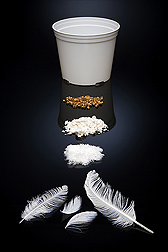Feathers to form green base for plastics

Processors from around the world are starting to take an interest in keratin resin, derived from poultry feathers. Less dense than plastic resins, the material, a thermoplastic and biodegradable, can be moulded neat or blended with standard thermoplastics to create “green” compounds.
There have been attempts before to derive plastic from poultry feathers, but officials at Mount Crawford, Virginia based Eastern Bioplastics, located in the largest poultry farming area of the US, believe they a step ahead of the competition.
“Our advantage is that we’ve developed a continuous process, using less energy (than others) and keeping it nearly fully automated, from feathers coming in one end of the plant to pellets being bagged on the other,” explained Sonny Meyerhoeffer, the company’s founder and principal.
Keratin
Feathers’ quills and fibres contain keratin, a material that can be processed much like standard thermoplastics.
Feathers are cleaned, chopped and extruded into strands that then are cut into odourless granules. Although naturally whitish/brown in colour, the keratin can be coloured easily.
Meyerhoeffer comes to the business with a broad poultry business background. Before starting Eastern Bioplastics, he led the founding of a co-op that took over a turkey processing plant slated with closure.
About three years ago, he began to seek a new challenge, settling on commercialization of keratin resins and he came into contact with Justin Barone, an associate professor at VA Tech., who was a researcher on the US Dept. of Agriculture-Agricultural Research Service (USDA-ARS) team that discovered these polymers could be processed into plastics.
Barone now is the R&D leader of the young company and also a stakeholder in it.
Steady supply
The company has eight to nine employees and developed its own machinery for processing the feathers.
In the US, poultry feathers sometimes are used as filler in cattle or poultry feed, but most of them end up in landfills. Brandon Waldron, who handles sales and marketing at the company, has lined up sufficient poultry processors to ensure a steady feather supply.
Eastern Bioplastics uses chicken feathers for its plastic rather than turkey feathers, as these latter feathers require greater processing, and thus energy, to create a good keratin.
According to the USDA-ARS, annually about 2 million tonnes of chicken feathers are left over after processing in the US.
Competitive pricing
The keratin from Eastern Bioplastics is priced to compete with standard thermoplastics.
Currently the company has focused its efforts mostly on development of grades for injection moulding. And R&D works on extrusion grades, such as those necessary to extrude agricultural films.
Unlike many plastics based on biomaterials, the keratin is not particularly sensitive to heat, with melt temperatures well above 90ºC.
Meyerhoeffer said processors’ in various sectors are interested in the product varying from moulders of single-use packaging and cutlery to ones serving the automotive and furniture markets, with these latter more interested in keratin blended with standard plastics.













